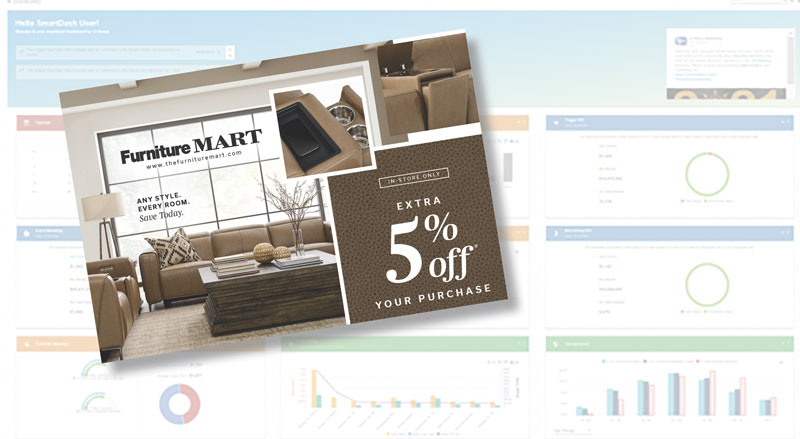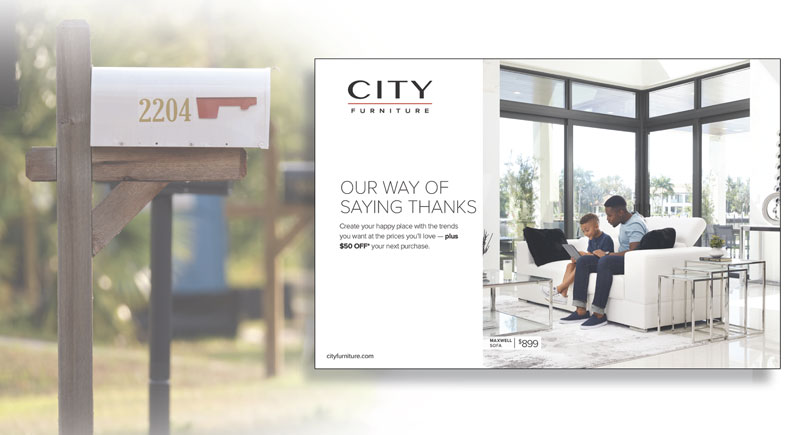Interview with Jeff Horowitz, LS Direct
As direct mail becomes more data-driven, some retailers are getting left
behind. Upgrading systems, adding control groups and doing A/B testing can
avoid waste and increase store traffic.
Furniture World spoke with Jeff Horowitz, President & CEO at LS Direct, to
get his thoughts on best direct mail advertising for the remainder of 2023.
Horowitz learned the ins and outs of the retail furniture business while
working at the New York-based retail operation his grandfather founded in
1946. “I joined the business right out of college,” he recalled. “My
interest was the marketing side of furniture retail, so I started supplying
inserts and preprinted circulars to other retailers. Then, as newspaper
readership declined and co-op dollars disappeared, our business evolved into
a data analytics and direct mail company serving retailers and larger,
vertically-integrated manufacturers.” Horowitz said it’s a great time to be
in the direct mail business. “Although the US postal service has experienced
significant declines in generic mail, the volume of variable mail products
sent to consumers has steadily increased over the past 20 years. Today,
retailers can print and send out 100,000 customized postcards at costs
similar to traditional bulk printing.“
Challenges
“The printing part of direct mail is easy,” he noted. “We find that the
biggest challenge for furniture retailers is getting the correct data out of
their point-of-sale systems. Aside from data entry issues, many still use
legacy POS systems. These kinds of issues make it much more difficult to
send the right messages to the right people at the right time.”

“Sales triggers are measured in two ways. The first is called last-touch
attribution, which gives 100% value to the last touch. A second is to use a
statistical model.”
Control Groups
Retailers know they need to advertise, but most don’t know how to attribute
specific campaigns and media to sales increases. “Other industries commonly
use control groups to obtain this information,” Horowitz said, “but most
furniture retailers are behind the curve and don’t use this option.
“When a pharmaceutical company tests a new drug,” He explained, “one patient
group gets the drug. A control group gets a placebo. When the trial is
completed, data from the groups is compared.” For direct mail trials,
instead of giving the control group a placebo, they don’t receive a mail
piece.
“To test a 10,000-piece mailing, we might first identify 20,000 individuals
who, for example, purchased in the past six months. Half of them get sent
the mailer and the other half become the control—non-mail group.
“If 100 people who were sent the mailer come in to purchase, but only 50
from the non-mail group do the same, we know that the mailer doubled the
number of buyers. It’s a way to measure how much incremental business direct
mail brings in. This type of analysis is something all retailers should do
for both their direct mail and digital campaigns.
“When doing this,” he added, “It’s important to recognize that direct mail
marketing efforts do not exist in a vacuum. Retailers almost always have
multiple marketing touchpoints. That makes it harder to figure out what
touchpoint triggers a sale.
“For example, if a retailer sends a postcard to a customer who lives at 123
Main Street, and that customer buys a sofa four days after the mailer
arrived, we call that attribution.” Sales triggers are measured in two main
ways. The first is called last-touch attribution, which gives 100% value to
the last touch. A second is to use a statistical model to reflect the
contributions of multiple touchpoints.
“For direct mail attribution,” Horowitz continued, “we always have a control
or hold-out group. Attribution for digital display and TV is more
complicated. We might send out a direct mail campaign paired with digital
exposure to measure the additive effect of the digital. Then, compare those
sales with a control group that received the mailer without concurrent
digital.”

“Using data from customers’ past interactions with a retailer is a much more
powerful data set to work with than purchasing demographic, psychographic
and geographic information.”
Digital Attribution
“Digital is great for online sales. Consumers see a digital ad, click on it
and can buy. The same applies to social media ads on platforms like Facebook
and Instagram. But most furniture retailers and furniture sales are
brick-and-mortar. So, how can retailers know if a consumer viewed an ad and
then visited the store?
“One option is to use secretive black box services from Google or Facebook
that report about groups of people who ‘might have’ seen an ad before
geolocating to a store location. But the fact is, due to recent consumer
privacy protections, brick-and-mortar attribution has become difficult or
even impossible to measure.”
A/B Message Testing
“A/B testing ad creative material or offers is useful to determine
efficacy,” he added. “It is the best way to prove what works well. A good
A/B test might be to mail 100,000 postcards with a 20% off offer, then vary
that message to a similar group with an offer of $100 off purchases of $500
or more. Testing mailer formats is also useful, such as comparing results
from a six-by-nine postcard versus a letter in an envelope.
“There are many other A/B testing options used to quantify effective ways to
reconnect with lapsed customers who haven’t purchased in three, four or five
years, or to test life event marketing approaches to attract new home
purchasers, people who recently had babies or newlyweds.”
Direct Mail Retargeting
The ability to target the right people at the right time with the right
products is the gold standard for any kind of marketing, including direct
mail. There are many ways to collect data and reveal timelines for possible
future purchases via effective customer journey lead generation and
follow-up systems.
“Collecting information from website browsers to retarget customers with
direct mail,” said Horowitz, “is another highly effective method.
“Right now, it’s possible to match up 70% of a retailer’s web traffic to a
physical address and then retarget people with direct mail,” he said.
“If a retailer can determine the products a website visitor landed on when
browsing, a postcard of a best-selling bedroom set, for example, that’s
similar in price or style to what that visitor viewed, can be mailed.
Received three to four days later, it reminds a potential customer of the
interest they showed. This is called intent-based marketing. The result is
that shoppers are helped to make more informed decisions, potentially
leading to purchases.
“Another advantage of postal retargeting is that it uses a first-party
cookie, a tag placed on a retailer’s website. To comply with current privacy
regulations regarding first-party cookies, retailers need only update
privacy policies on their websites to inform people about the information
they collect and how it will be used.
“It’s more targeted and effective than doing what many retailers have done
with traditional catalogs. Why send out a 100-page spring sale catalog when
it’s possible to quickly follow up with an offer for the product someone
just saw online? In the future, retailers will replace catalog mailings with
postcards sent out at the right time, with the right product to someone who
has shown an intent to buy.”

“The kind of direct mail campaigns we’ve discussed in this interview send
out a little mail every day to encourage customers to trickle in.”
Behavior Trumps Everything
“Using data from a customer’s past interactions with a retailer is a much
more powerful data set to work with than purchasing demographic,
psychographic and geographic information,” Horowitz continued. “When we say
‘behavior trumps everything,’ we refer to the benefit of targeting a
customer who bought a bedroom set two years ago and never returned to make
another purchase. Or someone who purchased items from different product
categories three times over the past four years. Acting on this type of
information produces the best results.
“A retailer’s customer database is its most valuable asset when used to keep
in touch with customers. It makes it possible to thank them after they buy,
send them direct mail offers for what they will likely purchase next, and
wish them a happy anniversary on a previous purchase. Event-based triggers
are effective. Tell them, ‘We’ve missed you. We have a new collection you
might be interested in.’”
High Impact Events
As Horowitz previously explained, there’s often a big difference between how
larger and small retailers use direct mail.
"Mid-sized and smaller retailers still tend to focus their direct mail
efforts on six-hour sales and high-impact events designed to drive traffic
over a short period,” he told Furniture World.
“The kind of direct mail campaigns we’ve discussed in this interview do the
exact opposite. They send out a little mail each day to create a regular,
consistent flow of shoppers. Doing that can be a challenge for smaller
retailers who operate from the gut or need to see their advertising dollars
get immediate results.”
Another roadblock smaller retailers experience is an inability to output
usable data. That gives their larger competitors a significant advantage.
“Unfortunately, it’s more difficult for companies like us to do data-driven
campaigns for smaller retailers,” Horowitz admitted. “There are a lot of
labor-intensive setups involved. However, smaller retailers can compete by
using web-to-print portals that offer more of a self-service model. That’s
something we are working on.
“Five years ago, 80% of our business focused on retail event
marketing—Fourth of July, Memorial Day, Labor Day sales events and
Open-to-Buys. We would help retailers mail 10,000 to 100,000 postcards a
weekend. Over 80% of our business today comes from continual monthly
evergreen mailings to create a consistent flow of shoppers. It’s a massive
shift in how retailers spend their marketing dollars.”
Furniture shoppers’ habits have also changed. “They want to choose when they
buy. Six-hour-only and one-day Macy’s type sales,” he said, “are
old-fashioned ways to attract consumers. It’s become necessary to be more
flexible and reach shoppers when they’re already in the market to buy.”
Other Suggestions
When asked to provide context for messaging that works and doesn’t work, he
replied, “Retailers who hope to sell slow-moving inventory with ad campaigns
are wasting advertising dollars. It didn’t work 50 years ago, and it’s not
working today. Bestsellers always bring the most people in. The more
aggressive the offer, the more traffic will come through the door. Customers
look for deals.
“Following up on leads,” he noted, “is important, but cost must be
considered when using direct mail to follow-up.” He said that there are
three main categories of potential furniture buyers. The first are customers
who have already made a purchase. The second includes ‘opportunities’ who
previously visited a store or engaged online but did not purchase. The third
category is comprised of prospects who do not have a relationship with a
store.
“We typically don’t recommend mailing to this third category unless there is
a trigger event, for example, a recent home purchase. It’s just too
expensive. Most other types of prospecting, such as mailing to people who
mirror a store’s best customers or targeting four homes around a house that
just received a delivery from a furniture retailer, typically aren’t
cost-effective for direct mail.”
He does not recommend fancy direct mail formats that add to the cost per
piece. “We’ve done scratch-offs, fold-overs and tried all kinds of other
cost-adding ideas. Retailers see better results by investing funds in
mailing more pieces. “If the choice is to invest 50 cents per piece to mail
100,000 regular postcards versus a dollar per piece to mail 50,000 larger
format mailers, sending the 50-cent piece is smarter. That’s because twice
the results per piece must be achieved for a mailer that costs twice as
much.”
Parting Advice
As a final suggestion to Furniture World readers, Horowitz advised, “If you
haven’t already updated your POS systems, it is one of the best investments
you can make. It’s hard to believe, but some stores still record data
manually, use Excel or QuickBooks. Modernizing point-of-sale systems for
effective data collection and output, linking those systems to websites and
working through third parties to purchase and get all that data fed through
is a best practice. Retailers that operate in the dark without effective
data feed-in and feed-out waste a sizable portion of their marketing
budgets.”